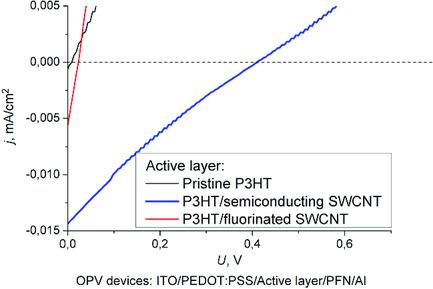当前位置:
X-MOL 学术
›
Phys. Status Solidi B
›
论文详情
Our official English website, www.x-mol.net, welcomes your
feedback! (Note: you will need to create a separate account there.)
Charge Photogeneration in Composites of Fluorinated Carbon Nanotubes and Semiconducting Polymer P3HT
Physica Status Solidi (B) - Basic Solid State Physics ( IF 1.5 ) Pub Date : 2020-07-18 , DOI: 10.1002/pssb.202000161 Elena S. Kobeleva 1, 2 , Danil A. Nevostruev 1 , Olga L. Krivenko 1 , Mikhail N. Uvarov 1 , Olga A. Gurova 3 , Egor V. Lobiak 3 , Alexay S. Berezin 3 , Vladimir A. Zinovyev 4 , Dmitriy E. Utkin 2, 4 , Konstantin M. Degtyarenko 5 , Leonid V. Kulik 1, 2
Physica Status Solidi (B) - Basic Solid State Physics ( IF 1.5 ) Pub Date : 2020-07-18 , DOI: 10.1002/pssb.202000161 Elena S. Kobeleva 1, 2 , Danil A. Nevostruev 1 , Olga L. Krivenko 1 , Mikhail N. Uvarov 1 , Olga A. Gurova 3 , Egor V. Lobiak 3 , Alexay S. Berezin 3 , Vladimir A. Zinovyev 4 , Dmitriy E. Utkin 2, 4 , Konstantin M. Degtyarenko 5 , Leonid V. Kulik 1, 2
Affiliation

|
Spectroscopic and photovoltaic properties of composites of purified and subsequently fluorinated single‐walled carbon nanotubes (F‐SWCNTs) with conjugated polymer poly(3‐hexylthiophene) (P3HT) are tested. Adding cyclohexanone into o‐dichlorobenzene solution of P3HT and F‐SWCNTs significantly affects the composite morphology and promotes P3HT/F‐SWCNT nanofilament formation, as evidenced from atomic force microscopy (AFM) images of spin‐coated composite films. Also, nanofilament formation enhances quenching of P3HT photoluminescence by F‐SWCNTs. The performance of P3HT‐based organic photovoltaics (OPV) devices with separated semiconducting SWCNTs and F‐SWCNTs as the acceptor component of the active layer is comparable. Light‐induced electron paramagnetic resonance (EPR) signal intensity in P3HT/F‐SWCNT composite films and frozen solutions grows with increase in F‐SWCNT content, which is a signature of photoinduced electron transfer. Dramatic change in SWCNT electronic structure upon fluorination is also evidenced by UV–vis– near infra red optical absorption spectra, from which the bandgap of about 1.0 eV is derived for F‐SWCNTs. Overall, the experimental results confirm that fluorination efficiently converts metallic SWCNTs into semiconducting ones, and F‐SWCNTs can be used for as an electron acceptor component in OPV devices, in combination with polymer donors. Presently, the performance of P3HT/F‐SWCNT devices is limited by F‐SWCNT aggregation into bundles, which decreases P3HT/F‐SWCNT interface area.
中文翻译:

氟化碳纳米管与半导体聚合物P3HT的复合材料中的电荷光生
测试了纯化和随后氟化的单壁碳纳米管(F-SWCNT)与共轭聚合物聚(3-己基噻吩)(P3HT)的复合材料的光谱和光电性能。将环己酮加入oP3HT和F-SWCNT的二氯苯溶液显着影响复合材料的形态,并促进P3HT / F-SWCNT纳米丝的形成,这从旋涂复合膜的原子力显微镜(AFM)图像中可以看出。此外,纳米丝的形成增强了F-SWCNT对P3HT光致发光的猝灭。具有分离的半导体SWCNT和F-SWCNT作为活性层的受主组分的基于P3HT的有机光伏(OPV)器件的性能是可比的。P3HT / F-SWCNT复合膜和冷冻溶液中的光诱导电子顺磁共振(EPR)信号强度随F-SWCNT含量的增加而增长,这是光诱导电子转移的标志。UV-vis-近红外光学吸收光谱也证明了氟化后SWCNT电子结构的剧烈变化,从中得出F‐SWCNT的带隙约为1.0 eV。总体而言,实验结果证实,氟化能有效地将金属SWCNT转变为半导体,F-SWCNT可与聚合物供体结合用作OPV器件中的电子受体组分。当前,P3HT / F-SWCNT设备的性能受到F-SWCNT聚合成束的限制,这会减小P3HT / F-SWCNT的接口面积。
更新日期:2020-07-18
中文翻译:

氟化碳纳米管与半导体聚合物P3HT的复合材料中的电荷光生
测试了纯化和随后氟化的单壁碳纳米管(F-SWCNT)与共轭聚合物聚(3-己基噻吩)(P3HT)的复合材料的光谱和光电性能。将环己酮加入oP3HT和F-SWCNT的二氯苯溶液显着影响复合材料的形态,并促进P3HT / F-SWCNT纳米丝的形成,这从旋涂复合膜的原子力显微镜(AFM)图像中可以看出。此外,纳米丝的形成增强了F-SWCNT对P3HT光致发光的猝灭。具有分离的半导体SWCNT和F-SWCNT作为活性层的受主组分的基于P3HT的有机光伏(OPV)器件的性能是可比的。P3HT / F-SWCNT复合膜和冷冻溶液中的光诱导电子顺磁共振(EPR)信号强度随F-SWCNT含量的增加而增长,这是光诱导电子转移的标志。UV-vis-近红外光学吸收光谱也证明了氟化后SWCNT电子结构的剧烈变化,从中得出F‐SWCNT的带隙约为1.0 eV。总体而言,实验结果证实,氟化能有效地将金属SWCNT转变为半导体,F-SWCNT可与聚合物供体结合用作OPV器件中的电子受体组分。当前,P3HT / F-SWCNT设备的性能受到F-SWCNT聚合成束的限制,这会减小P3HT / F-SWCNT的接口面积。











































 京公网安备 11010802027423号
京公网安备 11010802027423号